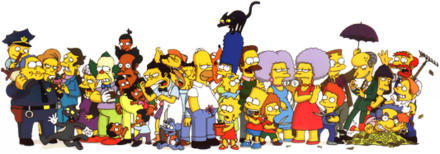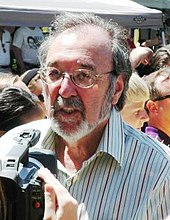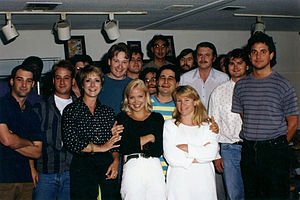The Simpsons theme by Alfie
Download: Simpsons_9.p3t

(1 background)
| The Simpsons | |
|---|---|
 | |
| Genre | |
| Created by | Matt Groening |
| Based on | The Simpsons shorts by Matt Groening |
| Developed by |
|
| Showrunners |
|
| Voices of | |
| Theme music composer | Danny Elfman |
| Opening theme | "The Simpsons Theme" |
| Ending theme | "The Simpsons Theme" (reprise) |
| Composers | Richard Gibbs (1989–1990) Alf Clausen (1990–2017) Bleeding Fingers Music (2017–present) |
| Country of origin | United States |
| Original language | English |
| No. of seasons | 35 |
| No. of episodes | 768 (list of episodes) |
| Production | |
| Executive producers | List
|
| Producers |
|
| Editors |
|
| Running time | 21–24 minutes |
| Production companies |
|
| Original release | |
| Network | Fox |
| Release | December 17, 1989 – present |
The Simpsons is an American animated sitcom created by Matt Groening for the Fox Broadcasting Company.[1][2][3] Developed by Groening, James L. Brooks, and Sam Simon, the series is a satirical depiction of American life, epitomized by the Simpson family, which consists of Homer, Marge, Bart, Lisa, and Maggie. Set in the fictional town of Springfield, it caricatures society, Western culture, television, and the human condition.
The family was conceived by Groening shortly before a solicitation for a series of animated shorts with producer Brooks. He created a dysfunctional family and named the characters after his own family members, substituting Bart for his own name; he thought Simpson was a funny name in that it sounded similar to "simpleton".[4] The shorts became a part of The Tracey Ullman Show on April 19, 1987. After three seasons, the sketch was developed into a half-hour prime time show and became Fox's first series to land in the Top 30 ratings in a season (1989–1990).
Since its debut on December 17, 1989, 768 episodes of the show have been broadcast. It is the longest-running American animated series, longest-running American sitcom, and the longest-running American scripted primetime television series, both in seasons and individual episodes. A feature-length film, The Simpsons Movie, was released in theaters worldwide on July 27, 2007, to critical and commercial success, with a sequel in development as of 2018. The series has also spawned numerous comic book series, video games, books, and other related media, as well as a billion-dollar merchandising industry. The Simpsons is a joint production by Gracie Films and 20th Television.[5]
On January 26, 2023, the series was renewed for its 35th and 36th seasons, taking the show through the 2024–25 television season.[6] Both seasons contain a combined total of 51 episodes. Seven of these episodes are season 34 holdovers, while the other 44 will be produced in the production cycle of the upcoming seasons, bringing the show's overall episode total up to 801.[7] Season 35 premiered on October 1, 2023.[8]
The Simpsons received widespread acclaim throughout its early seasons in the 1990s, which are generally considered its "golden age". Since then, it has been criticized for a perceived decline in quality. Time named it the 20th century's best television series,[9] and Erik Adams of The A.V. Club named it "television's crowning achievement regardless of format".[10] On January 14, 2000, the Simpson family was awarded a star on the Hollywood Walk of Fame. It has won dozens of awards since it debuted as a series, including 37 Primetime Emmy Awards, 34 Annie Awards, and 2 Peabody Awards. Homer's exclamatory catchphrase of "D'oh!" has been adopted into the English language, while The Simpsons has influenced many other later adult-oriented animated sitcom television series.
Premise[edit]
Characters[edit]
The main characters are the Simpson family, who live in the fictional "Middle America" town of Springfield.[11] Homer, the father, works as a safety inspector at the Springfield Nuclear Power Plant, a position at odds with his careless, buffoonish personality. He is married to Marge (née Bouvier), a stereotypical American housewife and mother. They have three children: Bart, a ten-year-old troublemaker and prankster; Lisa, a precocious eight-year-old activist; and Maggie, the baby of the family who rarely speaks, but communicates by sucking on a pacifier. Although the family is dysfunctional, many episodes examine their relationships and bonds with each other and they are often shown to care about one another.[12]
The family also owns a greyhound, Santa's Little Helper, (who first appeared in the episode "Simpsons Roasting on an Open Fire" and a cat, Snowball II, who is replaced by a cat also called Snowball II in the fifteenth-season episode "I, (Annoyed Grunt)-Bot".[13] Extended members of the Simpson and Bouvier family in the main cast include Homer's father Abe and Marge's sisters Patty and Selma. Marge's mother Jacqueline and Homer's mother Mona appear less frequently.

The show includes a vast array of quirky supporting characters, which include Homer's friends Barney Gumble, Lenny Leonard and Carl Carlson; the school principal Seymour Skinner and staff members such as Edna Krabappel and Groundskeeper Willie; students such as Milhouse Van Houten, Nelson Muntz and Ralph Wiggum; shopkeepers such as Apu Nahasapeemapetilon, Comic Book Guy and Moe Szyslak; government figures Mayor "Diamond" Joe Quimby and Clancy Wiggum; next-door neighbor Ned Flanders; local celebrities such as Krusty the Clown and news reporter Kent Brockman; nuclear tycoon Montgomery Burns and his devoted assistant Waylon Smithers; and dozens more.
The creators originally intended many of these characters as one-time jokes or for fulfilling needed functions in the town. A number of them have gained expanded roles and subsequently starred in their own episodes. According to Matt Groening, the show adopted the concept of a large supporting cast from the comedy show SCTV.[14]
Continuity and the floating timeline[edit]
Despite the depiction of yearly milestones such as holidays or birthdays passing, the characters never age. The series uses a floating timeline in which episodes generally take place in the year the episode is produced. Flashbacks and flashforwards do occasionally depict the characters at other points in their lives, with the timeline of these depictions also generally floating relative to the year the episode is produced. For example, the 1991 episodes "The Way We Was" and "I Married Marge" depict Homer and Marge as high schoolers in the 1970s who had Bart (who is always 10 years old) in the early '80s, while the 2008 episode "That '90s Show" depicts Homer and Marge as a childless couple in the '90s, and the 2021 episode "Do Pizza Bots Dream of Electric Guitars" portrays Homer as an adolescent in the same period. The 1995 episode "Lisa's Wedding" takes place during Lisa's college years in the then-future year of 2010, the same year the show began airing its 22nd season, in which Lisa was still 8. Regarding the contradictory flashbacks, Selman stated that "they all kind of happened in their imaginary world."[15]
The show follows a loose and inconsistent continuity. For example, Krusty the Clown may be able to read in one episode, but not in another. However, it is consistently portrayed that he is Jewish, that his father was a rabbi, and that his career began in the 1960s. The latter point introduces another snag in the floating timeline: historical periods that are a core part of a character's backstory remain so even when their age makes it unlikely or impossible, such as Grampa Simpson and Principal Skinner's respective service in World War II and Vietnam.
The only episodes not part of the series' main canon are the Treehouse of Horror episodes, which often feature the deaths of main characters. Characters who die in "regular" episodes, such as Maude Flanders, Mona Simpson and Edna Krabappel, however, stay dead. Most episodes end with the status quo being restored, though occasionally major changes will stick, such as Lisa's conversions to vegetarianism and Buddhism, the divorce of Milhouse van Houten's parents, and the marriage and subsequent parenthood of Apu and Manjula.
Setting[edit]
The Simpsons takes place in a fictional American town called Springfield. Although there are many real settlements in America named Springfield,[16] the town the show is set in is fictional. The state it is in is not established. In fact, the show is intentionally evasive with regard to Springfield's location.[17] Springfield's geography and that of its surroundings is inconsistent: from one episode to another, it may have coastlines, deserts, vast farmland, mountains, or whatever the story or joke requires.[18] Groening has said that Springfield has much in common with Portland, Oregon, the city where he grew up.[19] Groening has said that he named it after Springfield, Oregon, and the fictitious Springfield which was the setting of the series Father Knows Best. He "figured out that Springfield was one of the most common names for a city in the U.S. In anticipation of the success of the show, I thought, 'This will be cool; everyone will think it's their Springfield.' And they do."[20] Many landmarks, including street names, have connections to Portland.[21]
Production[edit]
Development[edit]

When producer James L. Brooks was working on the television variety show The Tracey Ullman Show, he decided to include small animated sketches before and after the commercial breaks. Having seen one of cartoonist Matt Groening's Life in Hell comic strips, Brooks asked Groening to pitch an idea for a series of animated shorts. Groening initially intended to present an animated version of his Life in Hell series.[22] However, Groening later realized that animating Life in Hell would require the rescinding of publication rights for his life's work. He therefore chose another approach while waiting in the lobby of Brooks's office for the pitch meeting, hurriedly formulating his version of a dysfunctional family that became the Simpsons.[22][23] He named the characters after his own family members, substituting "Bart" for his own name, adopting an anagram of the word brat.[22]
The Simpson family first appeared as shorts in The Tracey Ullman Show on April 19, 1987.[24] Groening submitted only basic sketches to the animators and assumed that the figures would be cleaned up in production. However, the animators merely re-traced his drawings, which led to the crude appearance of the characters in the initial shorts.[22] The animation was produced domestically at Klasky Csupo,[25][26] with Wes Archer, David Silverman, and Bill Kopp being animators for the first season.[27] The colorist, "Georgie" Gyorgyi Kovacs Peluce (Kovács Györgyike)[28][29][30][31][32][33] made the characters yellow; as Bart, Lisa and Maggie have no hairlines, she felt they would look strange if they were flesh-colored. Groening supported the decision, saying: "Marge is yellow with blue hair? That's hilarious — let's do it!"[27]
In 1989, a team of production companies adapted The Simpsons into a half-hour series for the Fox Broadcasting Company. The team included the Klasky Csupo animation house. Brooks negotiated a provision in the contract with the Fox network that prevented Fox from interfering with the show's content.[34] Groening said his goal in creating the show was to offer the audience an alternative to what he called "the mainstream trash" that they were watching.[35] The half-hour series premiered on December 17, 1989, with "Simpsons Roasting on an Open Fire".[36] "Some Enchanted Evening" was the first full-length episode produced, but it did not broadcast until May 1990, as the last episode of the first season, because of animation problems.[37] In 1992, Tracey Ullman filed a lawsuit against Fox, claiming that her show was the source of the series' success. The suit said she should receive a share of the profits of The Simpsons[38]—a claim rejected by the courts.[39]
Executive producers and showrunners[edit]

List of showrunners throughout the series' run:
- Season 1–2: Matt Groening, James L. Brooks, & Sam Simon
- Season 3–4: Al Jean & Mike Reiss
- Season 5–6: David Mirkin
- Season 7–8: Bill Oakley & Josh Weinstein
- Season 9–12: Mike Scully
- Season 13–31: Al Jean
- Season 32–present: Al Jean & Matt Selman
Matt Groening and James L. Brooks have served as executive producers during the show's entire history, and also function as creative consultants. Sam Simon, described by former Simpsons director Brad Bird as "the unsung hero" of the show,[40] served as creative supervisor for the first four seasons. He was constantly at odds with Groening, Brooks and the show's production company Gracie Films and left in 1993.[41] Before leaving, he negotiated a deal that sees him receive a share of the profits every year, and an executive producer credit despite not having worked on the show since 1993,[41][42] at least until his passing in 2015.[43] A more involved position on the show is the showrunner, who acts as head writer and manages the show's production for an entire season.[27]
Writing[edit]
The first team of writers, assembled by Sam Simon, consisted of John Swartzwelder, Jon Vitti, George Meyer, Jeff Martin, Al Jean, Mike Reiss, Jay Kogen and Wallace Wolodarsky.[44] Newer Simpsons' writing teams typically consist of sixteen writers who propose episode ideas at the beginning of each December.[45] The main writer of each episode writes the first draft. Group rewriting sessions develop final scripts by adding or removing jokes, inserting scenes, and calling for re-readings of lines by the show's vocal performers.[46] Until 2004,[47] George Meyer, who had developed the show since the first season, was active in these sessions. According to long-time writer Jon Vitti, Meyer usually invented the best lines in a given episode, even though other writers may receive script credits.[46] Each episode takes six months to produce so the show rarely comments on current events.[48]

Credited with sixty episodes, John Swartzwelder is the most prolific writer on The Simpsons.[49] One of the best-known former writers is Conan O'Brien, who contributed to several episodes in the early 1990s before replacing David Letterman as host of the talk show Late Night.[50] English comedian Ricky Gervais wrote the episode "Homer Simpson, This Is Your Wife", becoming the first celebrity both to write and guest star in the same episode.[51] Seth Rogen and Evan Goldberg, writers of the film Superbad, wrote the episode "Homer the Whopper", with Rogen voicing a character in it.[52]
At the end of 2007, the writers of The Simpsons went on strike together with the other members of the Writers Guild of America, East. The show's writers had joined the guild in 1998.[53]
In May 2023, the writers of The Simpsons went on strike together with the other members of the Writers Guild of America, East.[54][55]
Voice actors[edit]
| Cast members | ||||||||
|---|---|---|---|---|---|---|---|---|

|

|

|

|

| ||||
